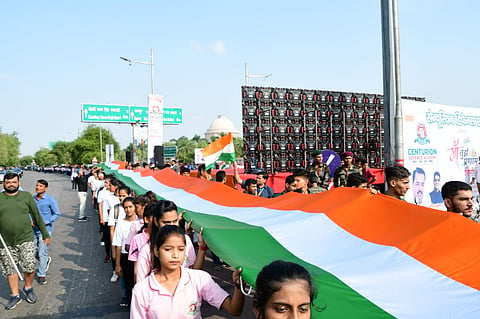Post Har Ghar Tiranga campaign, here’s how you can store the National Flag of India
Ae mere watan ke logon, the celebration of Independence Day under Har Ghar Tiranga campaign is over, and the time has come to take down the National Flags that were put up by common citizens across the country. This begs the question, how should you go about it?
The National Flag of India, also known as the ‘Tiranga’ holds a special place in the heart of every Indian. Citizens must practice care when taking the flag down, storing it, or laying it to rest. Read further to know about it’s dos and don'ts about storing the flag.
How to correctly fold the Tiranga
The National Flag represents the hopes and aspirations of the people of India. It is a symbol of our national pride. To honour the same, the Ministry of Culture, earlier this month issued a step-by-step guide on the correct way to fold the National Flag:
Step 1 - Place the flag horizontally
Step 2 - Fold the saffron and green bands under the middle white band
Step 3 - Fold the white band in such a way that only the Ashok Chakra is seen with parts of saffron and green bands
Step 4 - Carry the folded flag on palms or arms to store it
What not to do with the National Flag
Besides non-statutory instructions that the government issues periodically, the display of the National Flag is governed by the Prevention of Improper Use Act, 1950, and the Prevention of Insults to National Honour Act, 1971. The Flag Code of India, 2002, brings together all these laws, conventions, practices and instructions.
When the flag is damaged:
According to Part III of the Flag Code of India, “when a Flag is in a damaged or soiled condition, it shall not be cast aside or disrespectfully disposed of but be destroyed as a whole in a private, preferably by burning or by any other method consistent with the dignity of the Flag.”
Not to be used for any other purpose:
The Flag code says that “The Flag shall not be draped over the hood, top, sides or back of a vehicle, train or boat.” Further, the act specifies that the Flag shall not be used as a receptacle for receiving, delivering, holding or carry anything.
The Prevention of Insults to National Honour Act, 1971
Anyone found to be inconsistent with the rules and regulations mentioned under the act, is liable to be punished with imprisonment for a term which may extend to three years, or with a fine, or with both.
Tiranga Trivia!
The Tiranga was adopted through a resolution passed on July 22, 1947
It was the first symbol of ‘Free India‘
So far, the Indian National Flag has been modified 6 times
Colours of the national flag - saffron, white and green were initially indicative of the communities residing within the country
To get all the latest content, download our mobile application. Available for both iOS & Android devices.

